Variation of Internal Tides on the Continental Slope of the Southeastern East China Sea
Abstract
1. Introduction
2. Data and Methods
3. Results
4. Discussion
5. Conclusions
Author Contributions
Funding
Institutional Review Board Statement
Informed Consent Statement
Data Availability Statement
Acknowledgments
Conflicts of Interest
References
- Egbert, G.D.; Ray, R.D. Significant dissipation of tidal energy in the deep ocean inferred from satellite altimeter data. Nature 2000, 405, 775–778. [Google Scholar] [CrossRef]
- Egbert, G.D.; Ray, R.D. Semidiurnal and diurnal tidal dissipation from TOPEX/Poseidon altimetry. Geophys. Res. Lett. 2003, 30, 1907. [Google Scholar] [CrossRef]
- Zhao, Z.; Alford, M.H.; Girton, J.B. Mapping low-mode internal tides from multisatellite altimetry. Oceanography 2012, 25, 42–51. [Google Scholar] [CrossRef]
- Zhao, Z.; Alford, M.H.; Girton, J.B.; Rainville, L.; Simmons, H.L. Global observations of open-ocean mode-1 M2 Internal Tides. J. Phys. Oceanogr. 2016, 46, 1657–1684. [Google Scholar] [CrossRef]
- Baines, P.G. On internal tide generation models. Deep Sea Res. Part A—Oceanogr. Res. Pap. 1982, 29, 307–338. [Google Scholar] [CrossRef]
- Lamb, K.G. Numerical experiments of internal wave generation by strong tidal flow across a finite amplitude bank edge. J. Geophys. Res. 1994, 99, 843–864. [Google Scholar] [CrossRef]
- Garrett, C.; Kunze, E. Internal tide generation in the deep ocean. Ann. Rev. Fluid Mech. 2007, 39, 57–87. [Google Scholar] [CrossRef]
- Qian, H.; Shaw, P.T.; Ko, D.S. Generation of internal waves by barotropic tidal flow over a steep ridge. Deep-Sea Res. Part I—Oceanogr. Res. Pap. 2010, 57, 1521–1531. [Google Scholar] [CrossRef]
- Klymak, J.M.; Alford, M.H.; Pinkel, R.; Lien, R.C.; Tang, T.Y. The breaking and scattering of the internal tide on a continental slope. J. Phys. Oceanogr. 2011, 41, 926–945. [Google Scholar] [CrossRef]
- Rainville, L.; Pinkel, R. Baroclinic energy flux at the Hawaiian Ridge: Observations from the R/P FLIP. J. Phys. Oceanogr. 2006, 36, 1104–1122. [Google Scholar] [CrossRef]
- Zhao, Z.; Alford, M.H.; MacKinnon, J.A.; Pinkel, R. Long-range propagation of the semidiurnal internal tide from the Hawaiian Ridge. J. Phys. Oceanogr. 2010, 40, 713–736. [Google Scholar] [CrossRef]
- Zhao, Z. Internal tide radiation from the Luzon Strait. J. Geophys. Res. Ocean. 2014, 119, 5434–5448. [Google Scholar] [CrossRef]
- Xu, Z.; Liu, K.; Yin, B.; Zhao, Z.; Wang, Y.; Li, Q. Long-range propagation and associated variability of internal tides in the South China Sea. J. Geophys. Res. Ocean. 2016, 121, 8268–8286. [Google Scholar] [CrossRef]
- Eich, M.L.; Merrifield, M.A.; Alford, M.H. Structure and variability of semidiurnal internal tides in Mamala Bay, Hawaii. J. Geophys. Res.-Oceans 2004, 109, C5. [Google Scholar] [CrossRef]
- van Haren, H. Incoherent internal tidal currents in the deep ocean. Ocean Dyn. 2004, 54, 66–76. [Google Scholar] [CrossRef]
- van Aken, H.M.; van Haren, H.; Maas, L.R.M. The high-resolution vertical structure of internal tides and near-inertial waves measured with an ADCP over the continental slope in the Bay of Biscay. Deep. Sea Res. Part I Oceanogr. Res. Pap. 2007, 54, 533–556. [Google Scholar] [CrossRef]
- Garrett, C. Internal tides and ocean mixing. Science 2003, 301, 1858–1859. [Google Scholar] [CrossRef]
- Levitus, S.; Antonov, J.I.; Boyer, T.P.; Baranova, O.K.; Garcia, H.E.; Locarnini, R.A.; Mishonov, A.V.; Reagan, J.R.; Seidov, D.; Yarosh, E.S.; et al. World ocean heat content and thermosteric sea level change (0–2000 m), 1955–2010. Geophys. Res. Lett. 2012, 39, L10603. [Google Scholar] [CrossRef]
- Yang, J.; Zhou, S.H.; Zhou, J.X.; Lynch, J.F. Internal wave characteristics at the ASIAEX site in the East China Sea. IEEE J. Ocean. Eng. 2004, 29, 1054–1060. [Google Scholar] [CrossRef]
- Kuroda, Y.; Mitsudera, H. Observation of internal tides in the East China Sea with an underwater sliding vehicle. J. Geophys. Res. 1995, 100, 10801–10816. [Google Scholar] [CrossRef]
- Park, J.H.; Andres, M.; Martin, P.J.; Wimbush, M.; Watts, D.R. Second-mode internal tides in the East China Sea deduced from historical hydrocasts and a model. Geophys. Res. Lett. 2006, 33, L05602. [Google Scholar] [CrossRef]
- Park, J.H.; Jae, L.H.; Guo, B.H. Observation of semidiurnal internal tides and near-inertial waves at the shelf break of the East China Sea. Ocean. Polar Res. 2011, 33, 409–419. [Google Scholar] [CrossRef]
- Lien, R.C.; Sanford, T.B.; Jan, S.; Chang, M.H.; Ma, B.B. Internal tides on the East China Sea continental slope. J. Mar. Res. 2013, 71, 151–185. [Google Scholar] [CrossRef]
- Zhao, X.; Hou, Y.; Liu, Z.; Zhuang, Z.; Wang, K. Seasonal variability of internal tides northeast of Taiwan. J. Ocean Univ. China 2020, 19, 740–746. [Google Scholar] [CrossRef]
- Niwa, Y.; Hibiya, T. Three-dimensional numerical simulation of M2 internal tides in the East China Sea. J. Geophys. Res. 2004, 109, C04027. [Google Scholar] [CrossRef]
- Wang, Y.; Xu, Z.; Yin, B.; Hou, Y.; Chang, H. Long-range radiation and interference pattern of multisource M2 internal tides in the Philippine Sea. J. Geophys. Res. Oceans 2018, 123, 5091–5112. [Google Scholar] [CrossRef]
- Chang, H.; Xu, Z.; Yin, B.; Hou, Y.; Liu, Y.; Li, D.; Wang, Y.; Cao, S.; Liu, A.K. Generation and propagation of M2 internal tides modulated by the Kuroshio northeast of Taiwan. J. Geophys. Res. Ocean. 2019, 124, 2728–2749. [Google Scholar] [CrossRef]
- Hsu, M.K.; Liu, A.K.; Liu, C. A study of internal waves in the China Seas and Yellow Sea using SAR. Cont. Shelf Res. 2000, 20, 389–410. [Google Scholar] [CrossRef]
- Guo, X.; Miyazawa, Y.; Yamagata, T. The Kuroshio onshore intrusion along the shelf break of the East China Sea: The origin of the Tsushima Warm Current. J. Phys. Oceanogr. 2006, 36, 2205–2231. [Google Scholar] [CrossRef]
- Pawlowicz, R.; Beardsley, R.; Lentz, S. Classical tidal harmonic analysis including error estimates in MATLAB using T_TIDE. Comput. Geosci. 2002, 28, 929–937. [Google Scholar] [CrossRef]
- Welch, P. The use of fast Fourier transform for the estimation of power spectra: A method based on time averaging over short, modified periodograms. IEEE Trans. Audio Electroacoust. 1967, 15, 70–73. [Google Scholar] [CrossRef]
- Leaman, K.D.; Sanford, T.B. Vertical energy propagation of inertial waves: A vector spectral analysis of velocity profiles. J. Geophys. Res. 1975, 80, 1975–1978. [Google Scholar] [CrossRef]
- Varlamov, S.M.; Guo, X.; Miyama, T.; Ichikawa, K.; Waseda, T.; Miyazawa, Y. M2 baroclinic tide variability modulated by the ocean circulation south of Japan. J. Geophys. Res. Ocean. 2015, 120, 3681–3710. [Google Scholar] [CrossRef]
- Song, P.; Chen, X. Investigation of the internal tides in the northwest Pacific Ocean considering the background circulation and stratification. J. Phys. Oceanogr. 2021, 50, 3165–3188. [Google Scholar] [CrossRef]
- Xu, Z.; Wang, Y.; Liu, Z.; McWilliams, J.C.; Gan, J. Insight into the dynamics of the radiating internal tide associated with the Kuroshio Current. J. Geophys. Res. Ocean. 2021, 126, e2020JC017018. [Google Scholar] [CrossRef]
- Jithin, A.K.; Francis, P.A.; Unnikrishnan, A.S.; Ramakrishna, S.S.V.S. Energetics and spatio-temporal variability of semidiurnal internal tides in the Bay of Bengal and Andaman Sea. Prog. Oceanogr. 2020, 189, 102444. [Google Scholar] [CrossRef]
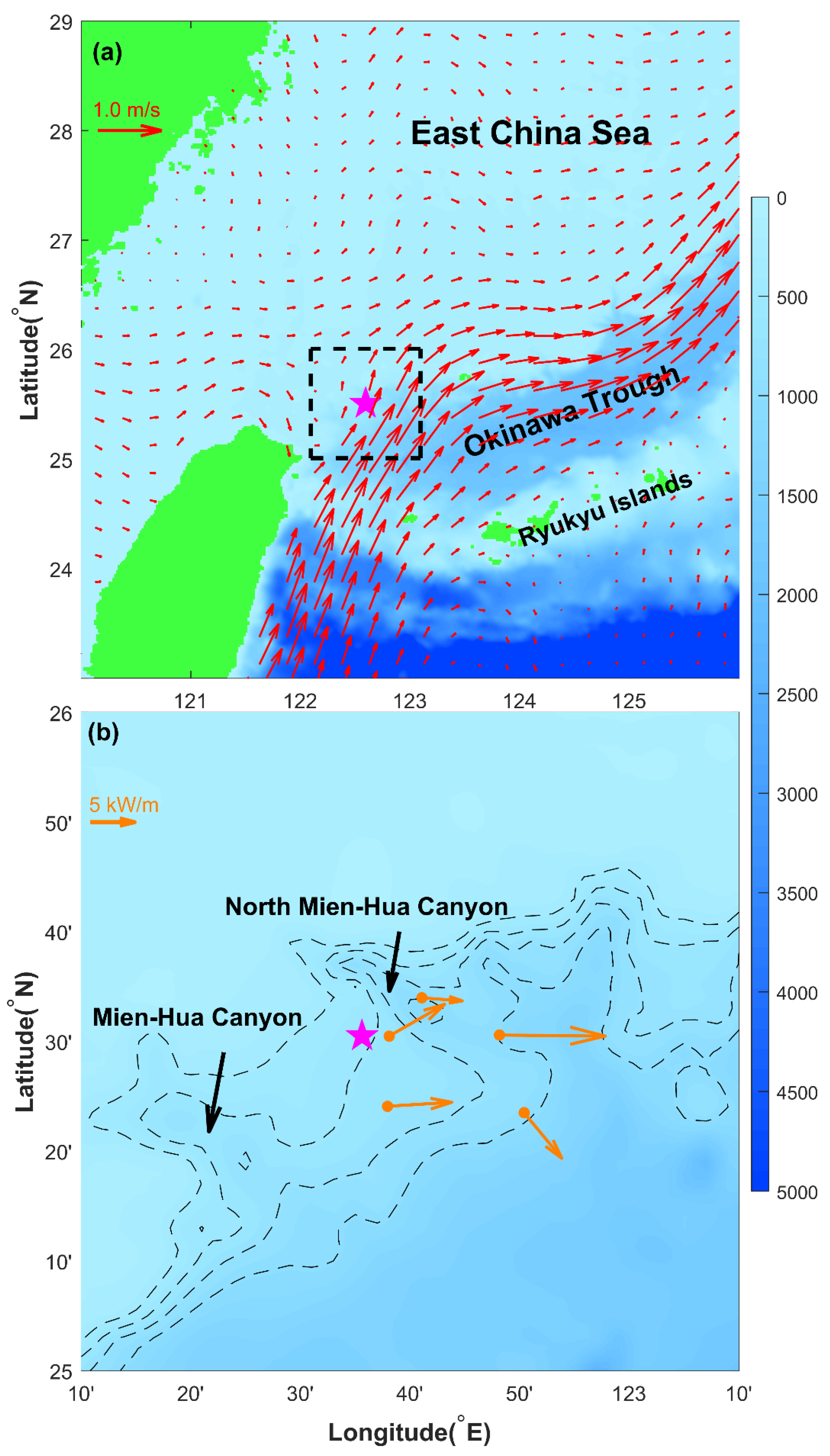
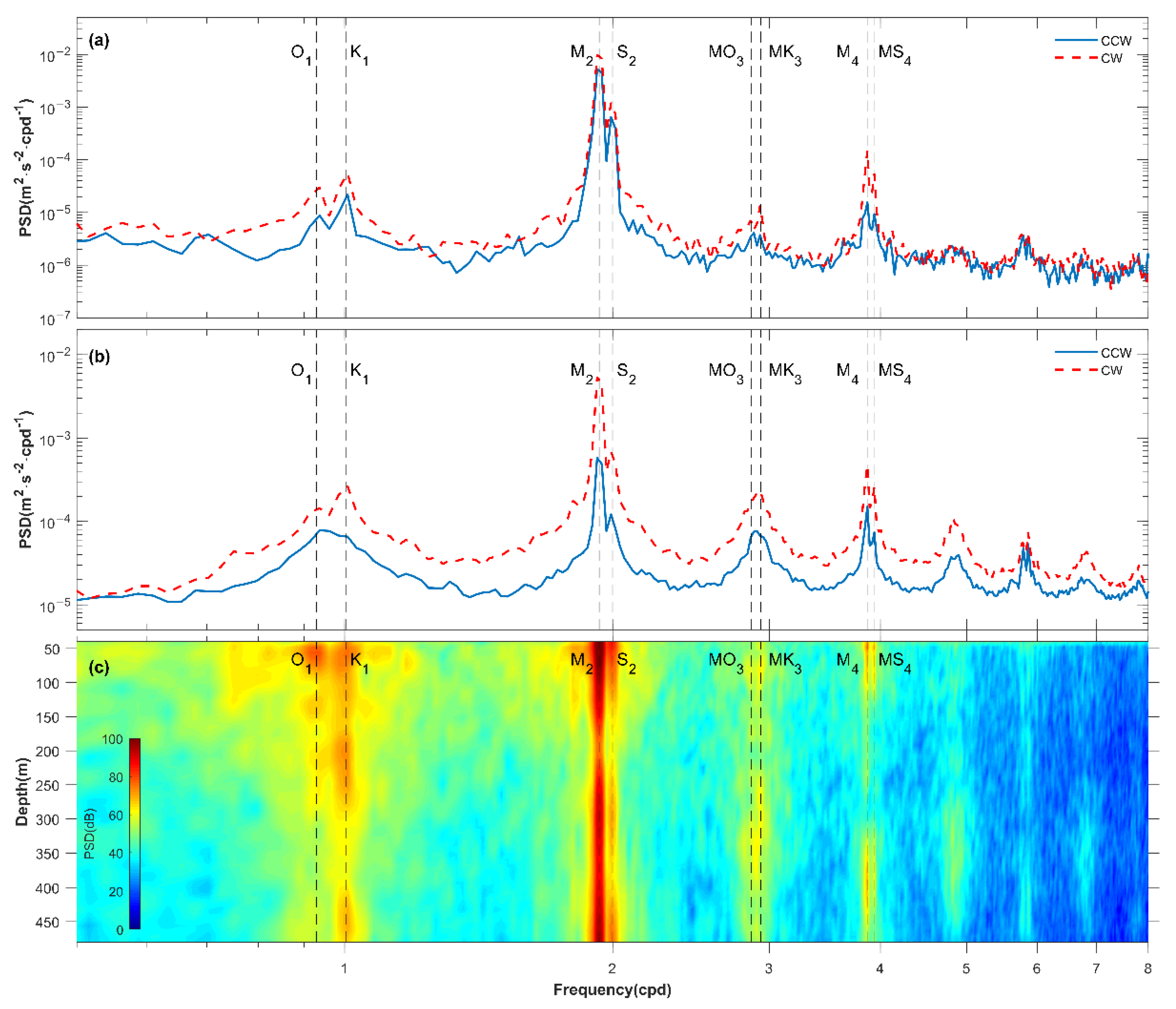
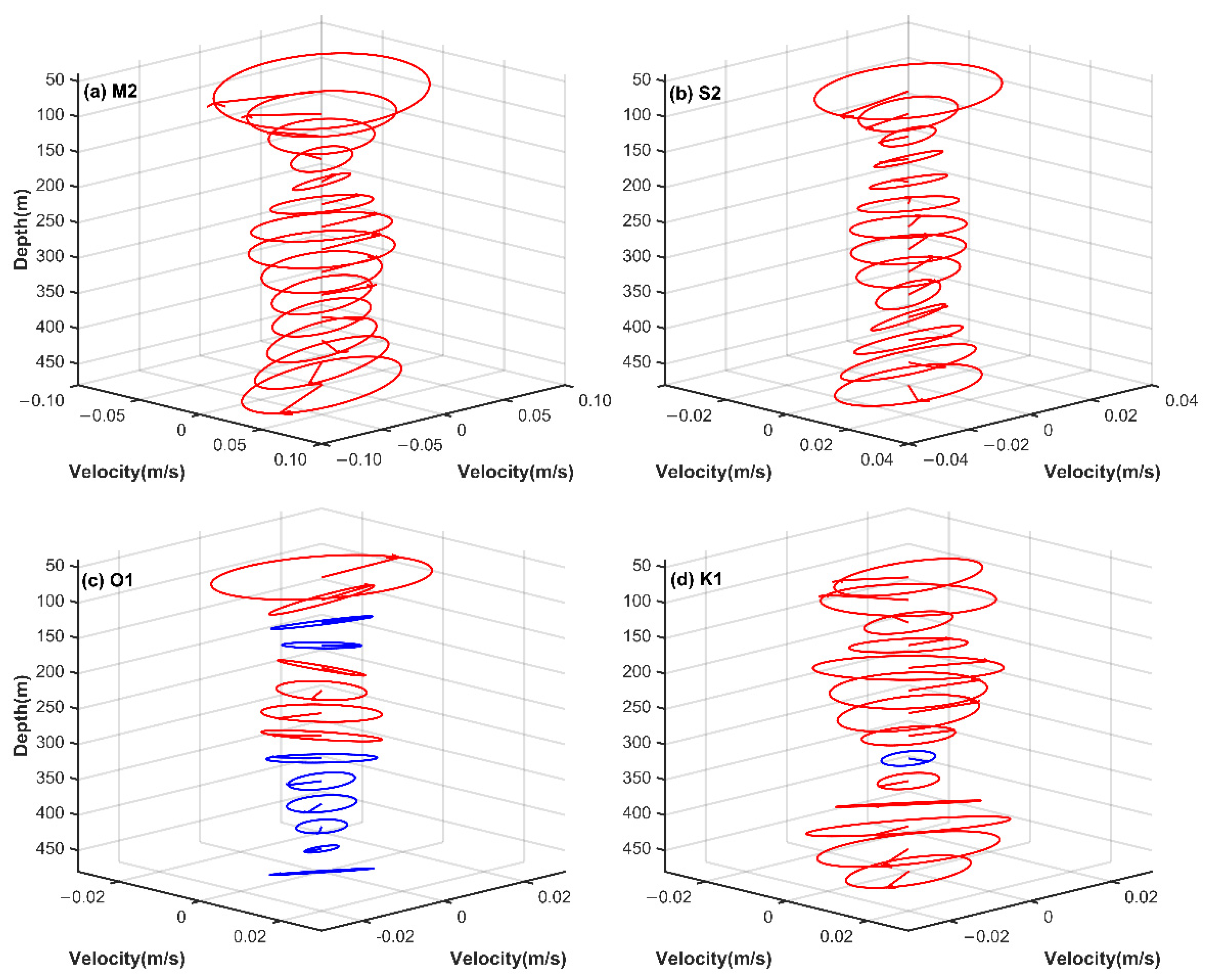
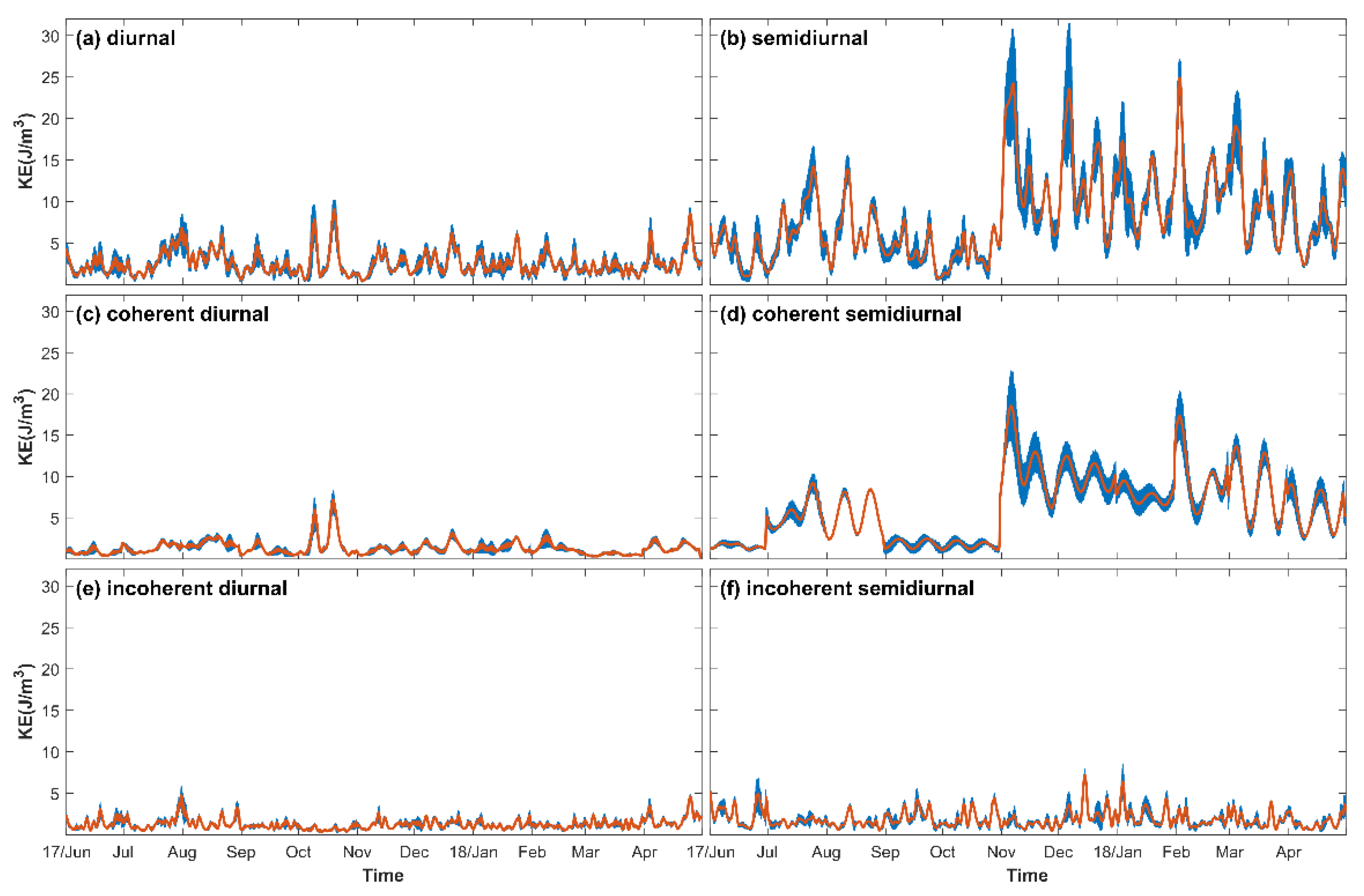
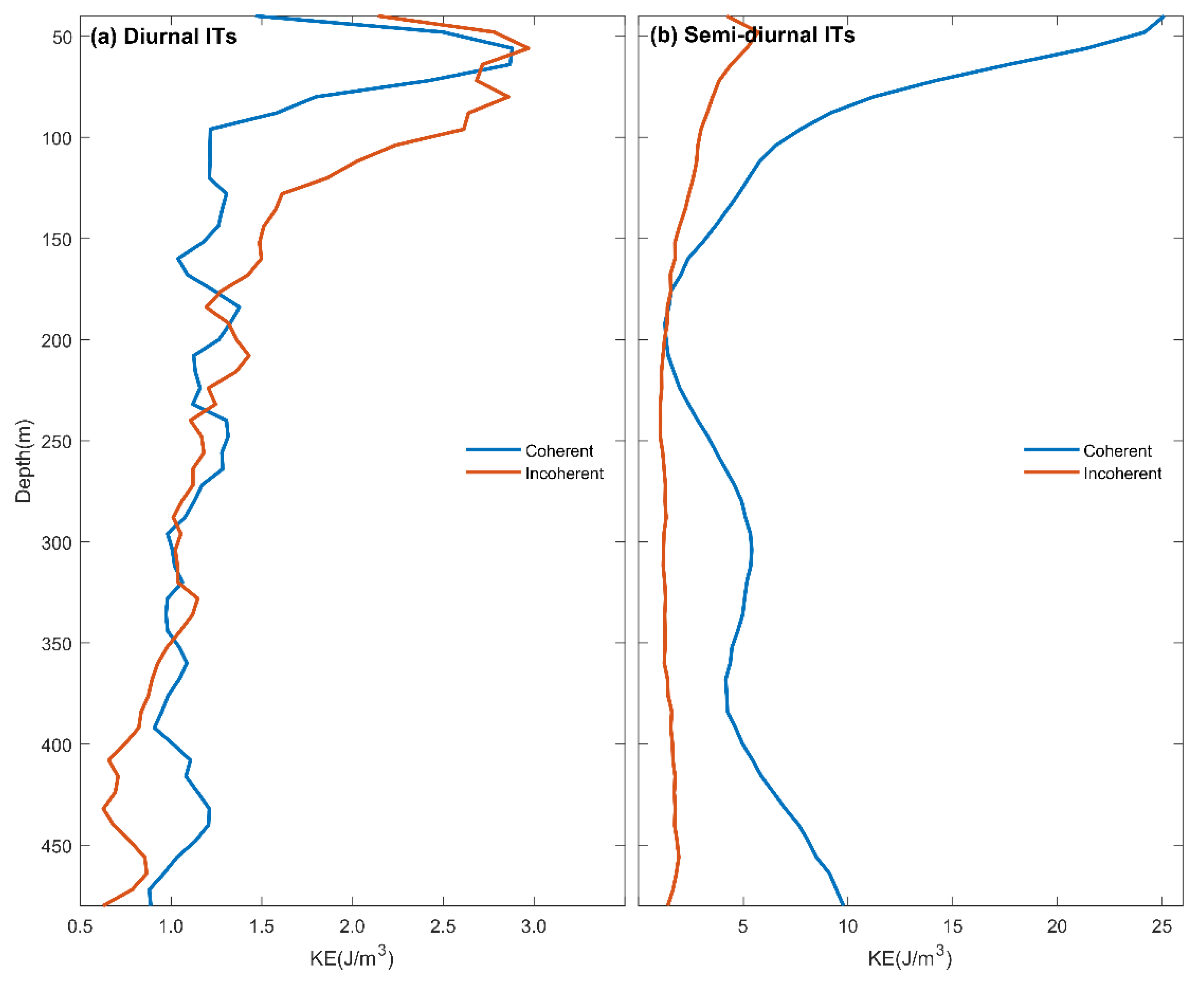
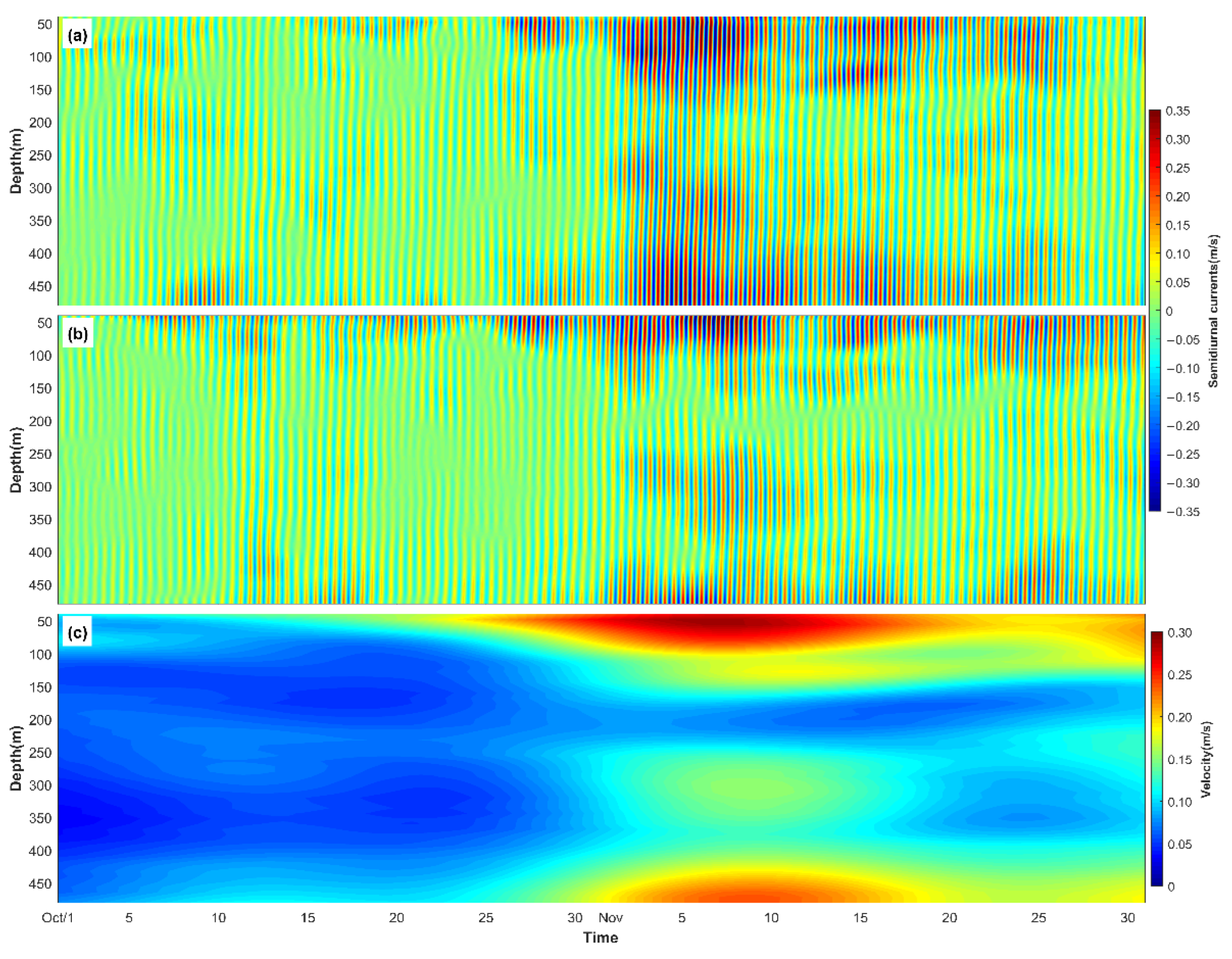
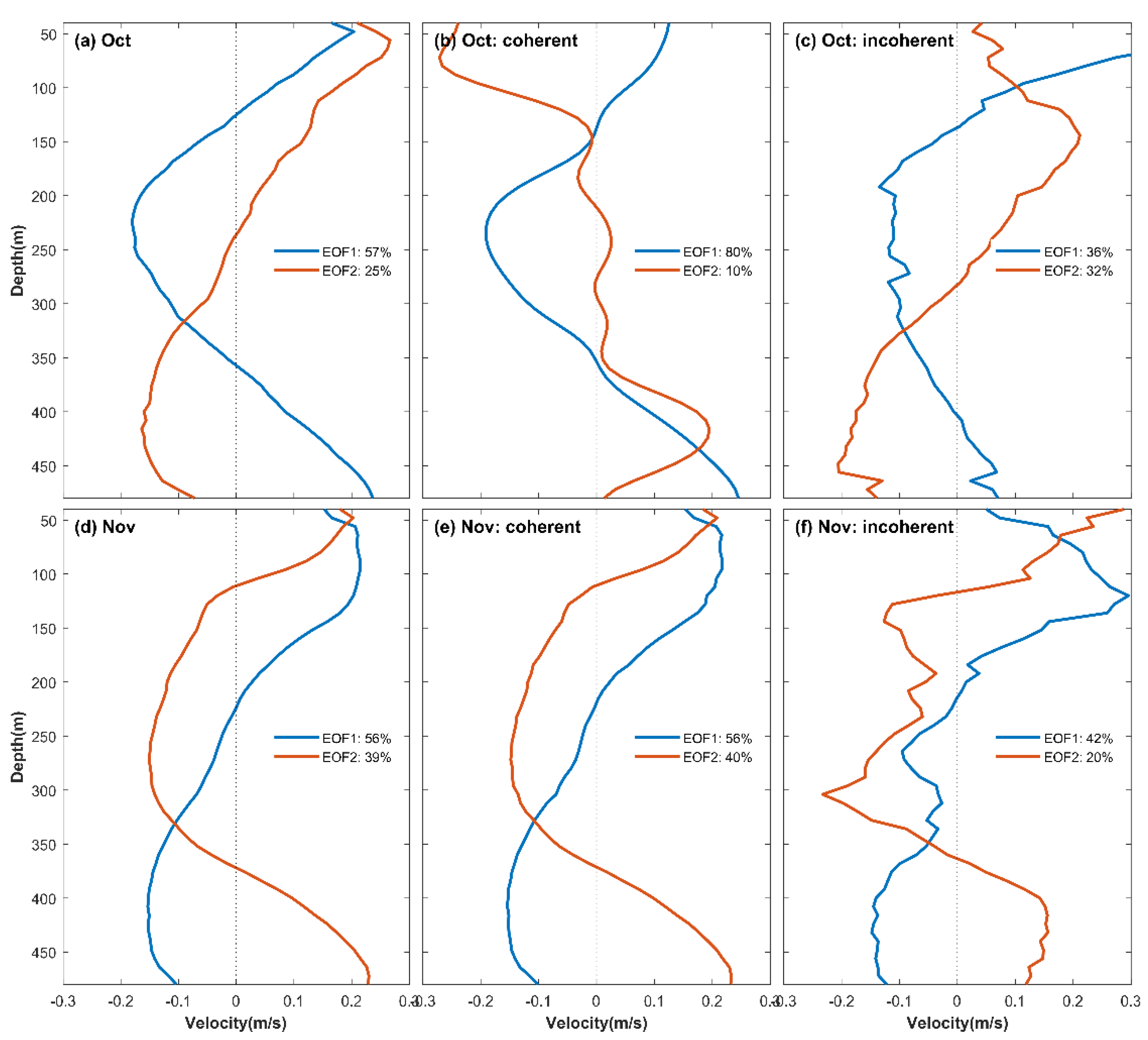
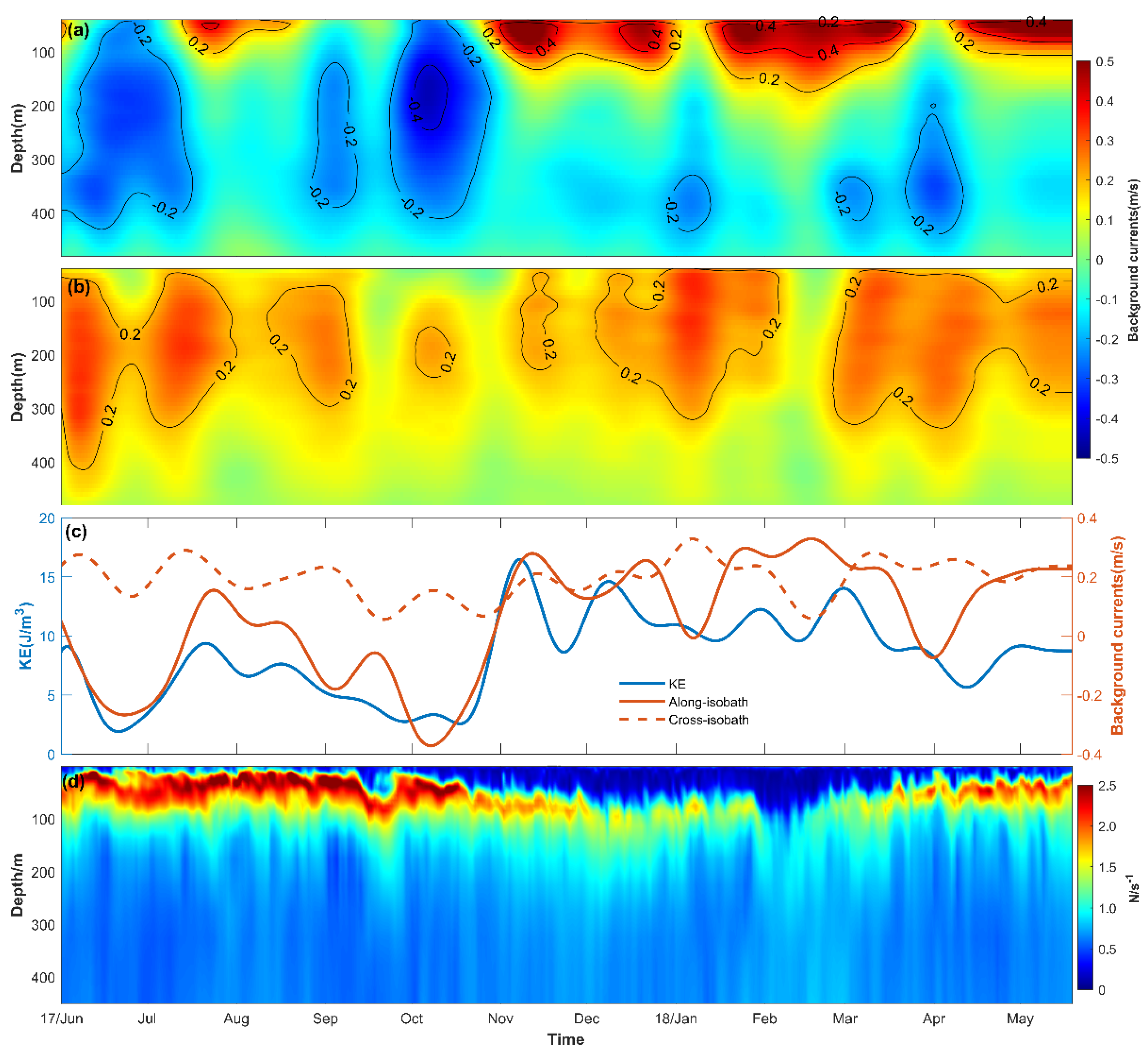
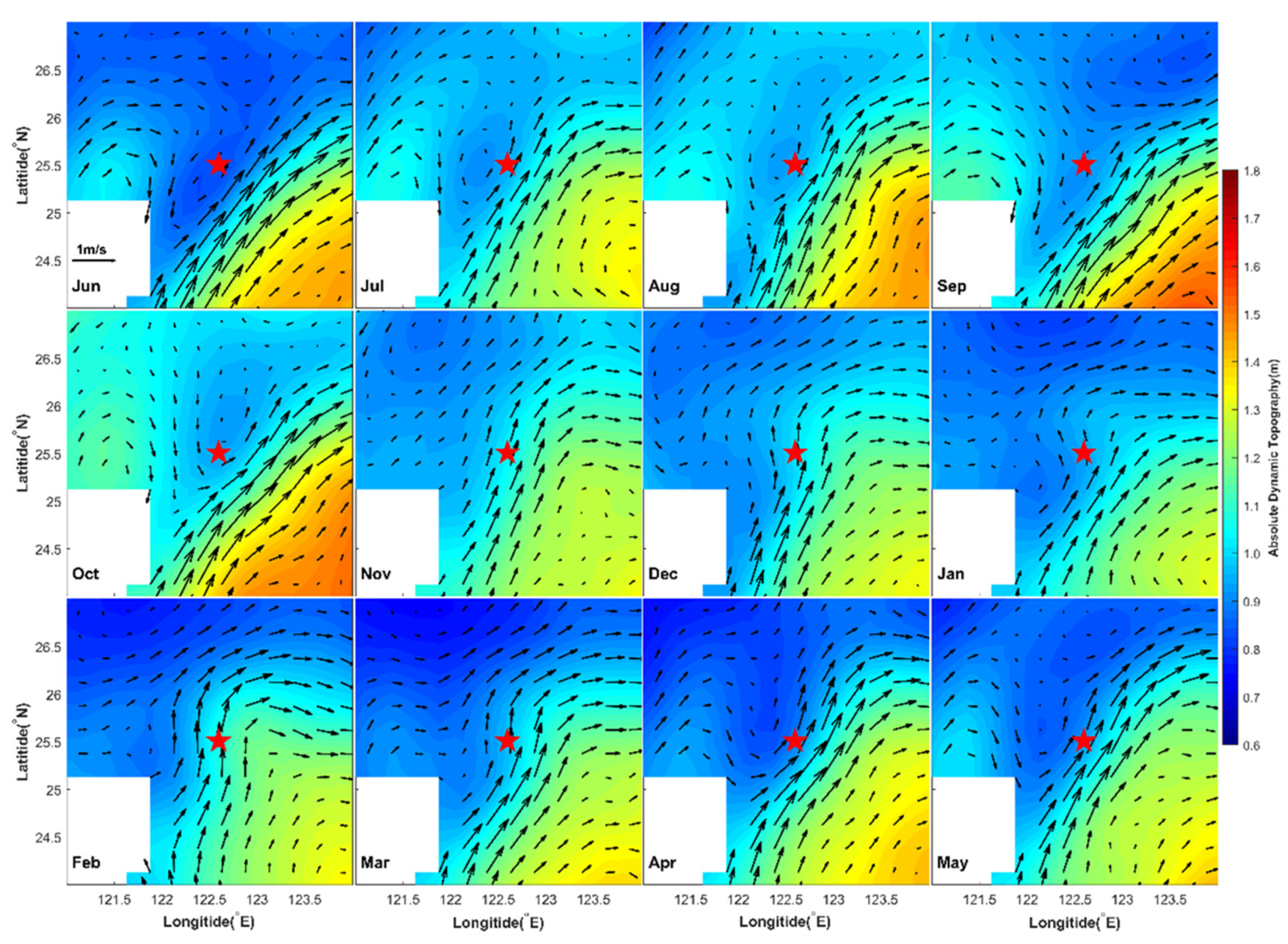
Publisher’s Note: MDPI stays neutral with regard to jurisdictional claims in published maps and institutional affiliations. |
© 2022 by the authors. Licensee MDPI, Basel, Switzerland. This article is an open access article distributed under the terms and conditions of the Creative Commons Attribution (CC BY) license (https://creativecommons.org/licenses/by/4.0/).
Share and Cite
Yang, B.; Hu, P.; Hou, Y. Variation of Internal Tides on the Continental Slope of the Southeastern East China Sea. J. Mar. Sci. Eng. 2022, 10, 104. https://doi.org/10.3390/jmse10010104
Yang B, Hu P, Hou Y. Variation of Internal Tides on the Continental Slope of the Southeastern East China Sea. Journal of Marine Science and Engineering. 2022; 10(1):104. https://doi.org/10.3390/jmse10010104
Chicago/Turabian StyleYang, Bing, Po Hu, and Yijun Hou. 2022. "Variation of Internal Tides on the Continental Slope of the Southeastern East China Sea" Journal of Marine Science and Engineering 10, no. 1: 104. https://doi.org/10.3390/jmse10010104
APA StyleYang, B., Hu, P., & Hou, Y. (2022). Variation of Internal Tides on the Continental Slope of the Southeastern East China Sea. Journal of Marine Science and Engineering, 10(1), 104. https://doi.org/10.3390/jmse10010104






